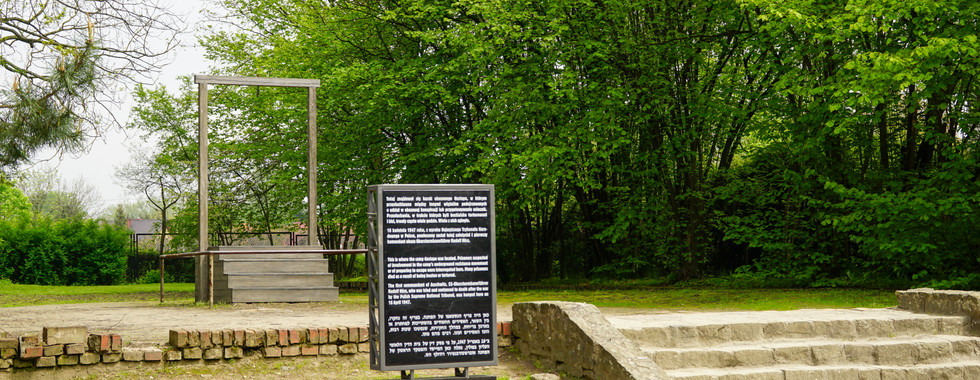Poland: Visiting Auschwitz
- The Curious Wanderer
- Jan 27, 2024
- 4 min read
Just over an hour outside the center of Krakow is Oswiecim, the Polish city whose name was changed to Auschwitz by the Nazis. Having booked a day-long tour, the Wanderer arrived at the entrance with a knot in her stomach, knowing that she was about to visit one of the most solemn and yet terrifying memorials in the world. She had anticipated a chill as she walked under the famous "Arbeit Macht Frei" arch but what caught her eye next was just as moving. It was May, and outside one of the first brick buildings in the complex was a lilac bush, in full bloom, proudly confirming that there is always hope for the renewal of life.

Auschwitz was established in 1940 as a concentration camp and internment center for political prisoners or people of ethnic or minority groups, including Jews, Poles, and Roma. In 1941, the camp was expanded to serve as an extermination center with facilities dedicated to the final solution: the murder all European Jews. Approximately 1.1 million people perished in Auschwitz in less than five years, one million of whom were Jews.
The camp was divided into three areas. Auschwitz I is the oldest, established in brick buildings formerly used as barracks by the Polish army. It was surrounded by electrified barbed wire and numerous guard houses. Our guided tour group was led through several of the buildings, most of which had space for 700 prisoners but actually housed up to 1200. Today, these buildings house permanent museum exhibitions including an explanation of the extermination process, various items seized from the Jews, presentations on the living conditions, and enlarged mugshots of prisoners with their name, number, and dates of arrival and death. Lavatories are preserved as they were used by the prisoners, including artwork that they painted on the walls.
A cinder block "death wall" stands in a courtyard outside one of the buildings. This was the site of the execution of several thousand Polish political prisoners who were shot by the SS. The wall was dismantled in 1944 and reconstructed as a museum exhibit. Another courtyard was used as a prisoner roll-call assembly area, with a gallows for public hangings. The first gas chamber and crematorium stands nearby, preserved largely in its original state. It was used as a prototype for executions from 1940 to 1943, closing when the larger facilities in Birkenau went into operation. Finally, signage marks the gallows where the first commandant of Auschwitz, who had been tried and sentenced to death, was hanged in 1947.
After completing the tour of Auschwitz I, our group boarded a bus for the short ride to Auschwitz II-Birkenau. This was the largest of the sub-camps in the complex and included facilities designed and built specifically for the mass extermination of Jews.
We entered the complex through the infamous arch over the railroad tracks that brought hundreds of cars loaded with prisoners into the camp. We were permitted to climb to the observation tower in the center of the arch, where the views gave chilling testament to the size and scope of the operation. A total of 300 barracks and buildings were constructed on the site, which encompassed 140 hectares and was surrounded by barbed wire fence. Brick chimneys marking the site of the wooden barracks seemed to stretch on forever; some of these buildings have been restored as part of the museum effort. On the opposite side of the rail line, low brick buildings housed female prisoners three to a bunk with minimal heat and very limited food.
Walking toward the back of the complex, we passed a red wooden rail car whose signage commemorates the 400,000 Jews who were deported from Hungary in more than 100 transports in 1944. Prisoners who were capable of working were housed under conditions that were ultimately not survivable; the remainder were sent to the gas chambers. At the end of the rail line, the observation tower over the entrance was just barely visible on the horizon, demonstrating again the enormous size of the camp. Four huge gas chambers and crematoria were built near the end of the rail line, with the goal of exterminating 1.6 million people per year. All four were destroyed by the Nazis near the end of the war.
In the decades since the end of World War II, much has been written by scholars and survivors whose knowledge and memories of Auschwitz are far more significant than what is presented here. Rather, these words and pictures represent the perspective of a visitor to the memorial who has experienced the essence of a place that bears witness to events that must never be permitted to happen again.
If you go:
The website of the Auschwitz-Birkenau Memorial and Museum provides a wealth of historical information, online tours, and information about visiting the site. https://www.auschwitz.org/en/
While admission to the grounds is free, the Memorial recommends joining a tour with a guide-educator and the Wanderer heartily agrees. These can be arranged through the Memorial website or through tour operators that depart from Krakow.













































Comments